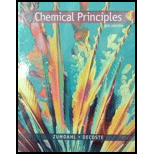
Concept explainers
Interpretation: The pressure in each given chamber of
Concept Introduction:The expression relating the pressure, P, volume, V with number of moles, n and temperature, T of an ideal gas is:
Where R is Universal gas constant.
Answer to Problem 164CP
Explanation of Solution
Given:
Two sample of gases, one of pure helium and the other is pure radon, separated in two rectangular 1.00 L chambers by thin metal wall.
Temperature for both the samples =
A circular hole is developed of radius
Converting temperature from degree Celsius to Kelvin as:
The ratio of number of moles to volume (which is equal for both the gases as temperature is same) is calculated using ideal gas equation as:
Converting this value from
Calculating the area,
Where r is radius.
Substituting the values:
Now, the number of collisions is calculated using formula:
Where,
The number of collisions for He will be:
The number of collisions for Rn will be:
The rate of collisions is assumed to be constant, so, the number of molecules transferred into another chamber is:
Now, the original amount of gas is calculated using ideal gas equation as:
Side that began with He now contains:
Total moles are:
So, the final pressure of He in container is:
Side that began with Rn now contains:
Total moles are:
So, the final pressure of Rn in container is:
Want to see more full solutions like this?
Chapter 5 Solutions
CHEM.PRINC.W/OWL2+REBATE+2 SUPPL.>IP<
- Sulfur trioxide, SO3, is produced in enormous quantities each year for use in the synthesis of sulfuric acid. S(s)+O2(g)SO2(g)2SO2(g)+O2(g)2SO3(g) What volume of O2(g) at 350.C and a pressure of 5.25 atm is needed to completely convert 5.00 g sulfur to sulfur trioxide?arrow_forward50 The first step in processing zinc metal from its ore, ZnS, is to react it with O2 according to the reaction 2ZnS(s)+3O2(g)2ZnO(s)+2SO2(g) If 620 kg of ZnS is to be reacted, what volume of oxygen at 0.977 atm 34.0 C is needed (at a minimum) to carry out this reaction?arrow_forwardThe following figure shows three 1.00-L bulbs connected by valves. Each bulb contains argon gas with amounts proportional to the number of circles pictorially represented in the chamber. All three bulbs are maintained at the same temperature. Unless stated otherwise, assume that the valves connecting the bulbs are closed and seal the gases in their respective chambers. Assume also that the volume between each bulb is negligible. (a) Which bulb has the highest pressure? (b) If the pressure in bulb A is 0.500 atm, what is the pressure in bulb C? (c) If the pressure in bulb A is 0.500 atm, what is the total pressure? (d) If the pressure in bulb A is 0.500 arm, and the valve between bulbs A and B is opened, redraw the figure shown above to accurately represent the gas atoms in all three bulbs. What is P A+P B+P C? Compare your answer in part (d) to that in part (c). (e) Follow the instructions of part (d) but now open only the valve between bulbs B and C.arrow_forward
- A sample of a smoke stack emission was collected into a 1.25-L tank at 752 mm Hg and analyzed. The analysis showed 92% CO2, 3.6% NO, 1.2% SO2, and 4.1% H2O by mass. What is the partial pressure exerted by each gas?arrow_forwardNitrogen trifluoride gas reacts with steam to produce the gases HF, NO, and NO2. (a) Write a balanced equation for the reaction. (b) What volume of nitrogen oxide is formed when 5.22 L of nitrogen trifluoride are made to react with 5.22 L of steam? Assume 100% yield and constant temperature and pressure conditions throughout the reaction.arrow_forward
 Physical ChemistryChemistryISBN:9781133958437Author:Ball, David W. (david Warren), BAER, TomasPublisher:Wadsworth Cengage Learning,
Physical ChemistryChemistryISBN:9781133958437Author:Ball, David W. (david Warren), BAER, TomasPublisher:Wadsworth Cengage Learning, Chemistry: Principles and ReactionsChemistryISBN:9781305079373Author:William L. Masterton, Cecile N. HurleyPublisher:Cengage Learning
Chemistry: Principles and ReactionsChemistryISBN:9781305079373Author:William L. Masterton, Cecile N. HurleyPublisher:Cengage Learning Chemistry: The Molecular ScienceChemistryISBN:9781285199047Author:John W. Moore, Conrad L. StanitskiPublisher:Cengage Learning
Chemistry: The Molecular ScienceChemistryISBN:9781285199047Author:John W. Moore, Conrad L. StanitskiPublisher:Cengage Learning ChemistryChemistryISBN:9781305957404Author:Steven S. Zumdahl, Susan A. Zumdahl, Donald J. DeCostePublisher:Cengage Learning
ChemistryChemistryISBN:9781305957404Author:Steven S. Zumdahl, Susan A. Zumdahl, Donald J. DeCostePublisher:Cengage Learning
 Chemistry: An Atoms First ApproachChemistryISBN:9781305079243Author:Steven S. Zumdahl, Susan A. ZumdahlPublisher:Cengage Learning
Chemistry: An Atoms First ApproachChemistryISBN:9781305079243Author:Steven S. Zumdahl, Susan A. ZumdahlPublisher:Cengage Learning





